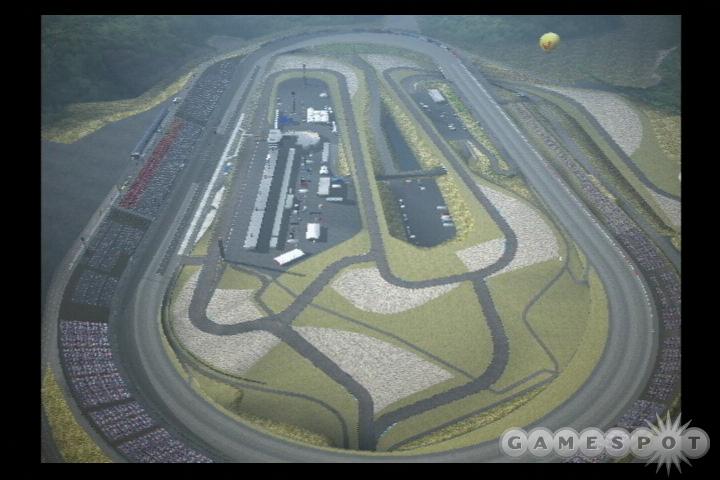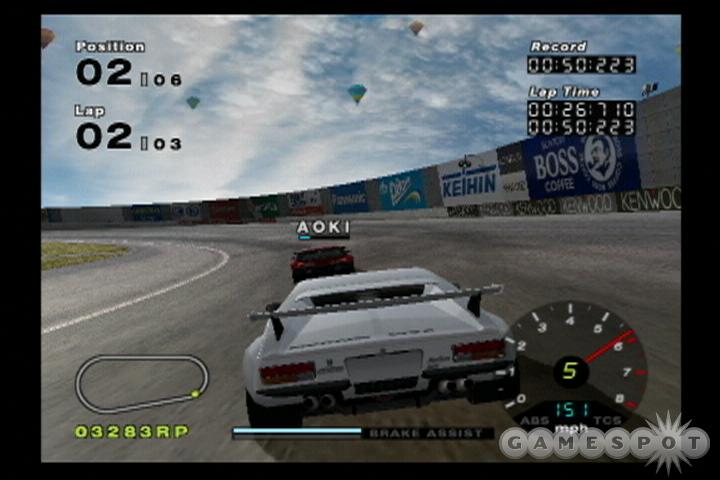When it comes to racing games, much of Namco's recent focus has been on its popular motorcycle racing series for the PlayStation 2, MotoGP. But the company also has a history with racing of the four-wheeled variety with the seemingly dormant Ridge Racer series. R: Racing Evolution is Namco's latest, and it's an entirely different beast that has more in common with Namco's motorcycle efforts than with the more arcade-friendly racing the Ridge Racer series is known for. Still, it's a game that tries to walk the line, so to speak, offering a driving model with simulation-like configuration options while also trying to be novice-friendly with relatively easy handling and a braking assistance option. Unfortunately, as with most games that try to cater to both crowds, R: Racing Evolution fails to impress regardless of which side of the fence you're on.

Most games these days try to find a hook or gimmick that can help to differentiate them from the pack. Given the overcrowded state of the racing genre, these gimmicks are perhaps more important than ever. R: Racing Evolution's twist on the standard racing game is the pressure meter. When you get behind an opposing vehicle and ride in its slipstream, a meter appears and slowly fills. This is meant to show that you're applying pressure to another driver. When the meter fills, it begins blinking red, and the AI driver you're heating up will make a mistake, usually spinning out around the next turn. While it's sort of an interesting idea, R's pressure meter is a one-trick pony that doesn't really add much in the way of strategy to the game. It just means that you'll never have to wait for a real opening to pass, since you can just ride in someone's wake and wait for that driver to blow it. Since each race contains only six cars, you'll have to beat only five cars to get to the front of the pack, and staying there isn't very tough. The game's brake assist feature, which defaults to on, only serves to make the game even easier, since you can play most of the game with the accelerator pegged and let the assist feature decide how fast you should be taking any given turn. Serious race fans are advised to turn the brake assist off from the get-go, though the overall physics model for the driving itself isn't particularly noteworthy either way.
R's main mode is known as racing life. Much like the main mode in Codemasters' Pro Race Driver, racing life mode is a fixed story-driven mode that lets you play as Rena, a young Japanese woman who goes from driving ambulances to the top of the professional racing circuit. Racing life is broken up into 14 chapters, and each one is separated by a cutscene that advances the story. As you progress, Rena becomes a famous driver, and you'll witness rivalries develop and other relationships unfold as she moves up the ladder. The story does a pretty good job at keeping you interested in what would otherwise be a dull and easy set of races. Racing life takes you through most of the different options that the game has to offer, so you'll drive in multirace tournaments, one-off races, rally races, and drag races. The only requirement is that you need to win races to proceed. You'll have some control over the difficulty and car selection, but the default options and vehicles are usually more than enough to win.
The other modes let you select the sorts of races you want to drive in and give you the ability to choose different cars, tracks, and so on. The inclusion of rally racing and drag races is a great idea, since it helps to break up the sometimes-monotonous action of racing on the circuits included in the game, but neither portion is done particularly well. Rally racing takes place on off-road tracks and gives you a standard rally racing copilot that shouts out turns and hazards to you while you drive. Unfortunately, the voice technology used to stitch the copilot's phrases together sounds like it was ripped out of a Super Nintendo game, so the resulting delivery is incredibly stilted. Drag racing is especially simple, as all you really need to do is let off the brake when the race starts and hit the nitro boost button when an onscreen indicator lights up. The recent Need for Speed Underground does far more interesting things with drag racing. As you complete races, you earn points that can be used to purchase more cars or races, as well as to upgrade existing cars in the categories of weight reduction and horsepower. The game contains several different car classes, including some rally vehicles, a pair of American muscle cars, and several more. The game uses licensed cars, and contains automobiles from manufactures such as Dodge, Chevy, Honda, Volkswagen, Mitsubishi, Subaru, Nissan, Toyota, Audi, Acura, Ford, Hummer, Renault, and Alfa Romeo.
Though the driving in R isn't particularly great, you have a good level of control over your vehicle, and the difference between the cars feels very real, not only in terms of speed and acceleration, but also in the handling. You won't confuse it for Gran Turismo or Project Gotham Racing, but overall the game at least does a nice job of transferring your input into onscreen action. The GameCube and Xbox versions do this even better, thanks to their squishy analog triggers that really let you apply the right amount of gas and brake in any given situation. The PS2's Dual Shock 2 also offers analog button control, but it isn't as fine as it is on the other consoles.
Graphically, R has the look of a game that started out on the PlayStation 2 and made its way to the more powerful consoles from there. It looks good across the board, but the Xbox version won't stand up terribly favorably to that system's best racers. The two-player split-screen option holds up pretty well on all systems, maintaining a fairly steady frame rate. All versions of the game display various amounts of aliasing, and the game never seems to be able to deliver a convincing sense of speed, making it seem sluggish, even when driving faster cars. The trackside detail is passable, and the car models look good, but overall R's look is nothing special.
The sound in R could have used a little more work. Since it's a story-driven game, there's a lot of voice--your pit crew leader is constantly yammering at you as you drive, and you'll hear from the other drivers as you race. The pit crew voices tend to be OK, but the comments from the other drivers tend to be repeated way too often to make any real impact. There also aren't very many different driver voices, so you'll hear the same shrill comments from different drivers. Other racing games have proved that engine and exhaust noises can be full of character and nuance. But aside from the rally cars, which backfire here and there, most of R's cars have the droning sound of a lawnmower. When stacked up six deep, the engine noises really become pretty grating.

R: Racing Evolution doesn't live up to Namco's other work in the genre, be it from the motorcycle side or from the arcade-style racing side. It attempts to deliver some simulation-styled thrills, but the driving physics and options simply aren't up to snuff when compared to other, better games. On the other side, the addition of brake assist turns the game into an overly simplified affair that reduces the gameplay to holding down the gas pedal and steering. Regardless of your console of choice, each system has at least one racing game that is far superior to R: Racing Evolution.